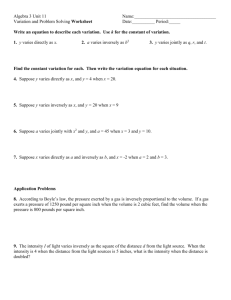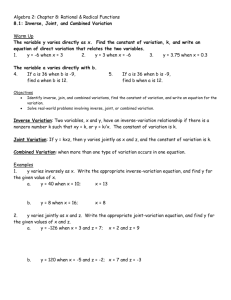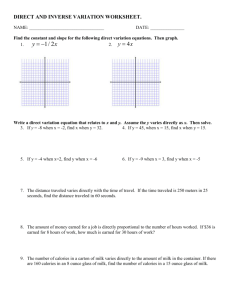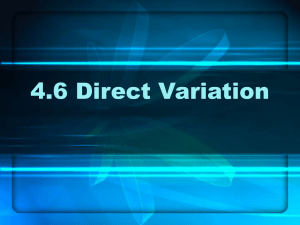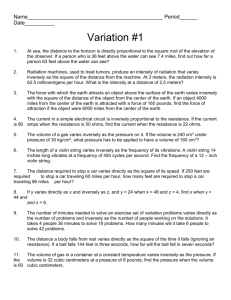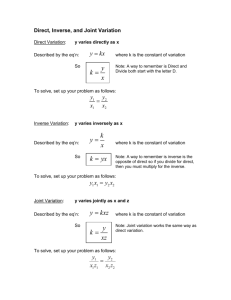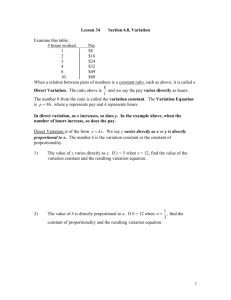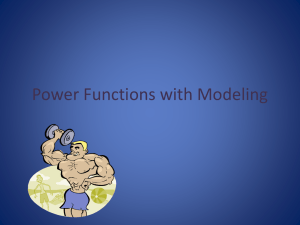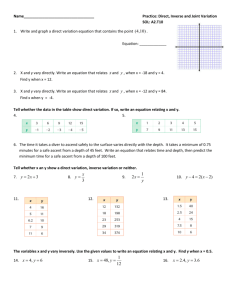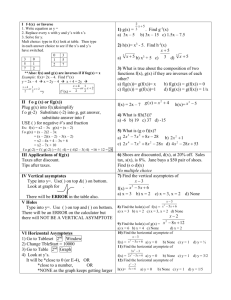chapter 2 problems
advertisement
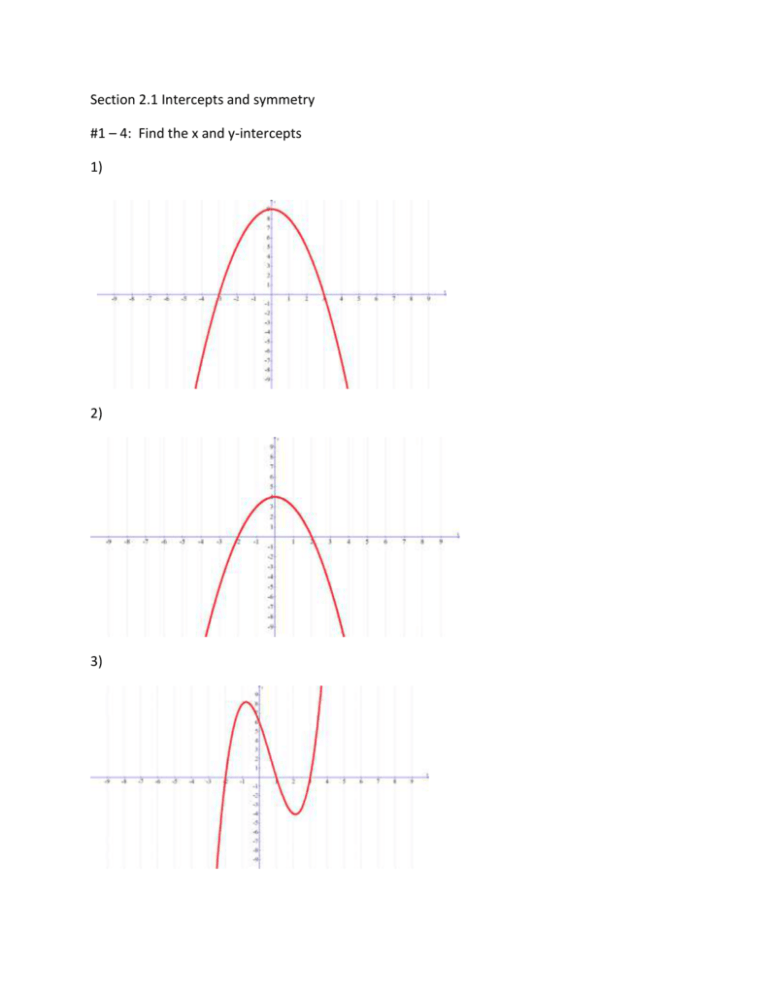
Section 2.1 Intercepts and symmetry #1 – 4: Find the x and y-intercepts 1) 2) 3) Section 2.1 Intercepts and symmetry 4) #5-18: Find the x and y-intercepts. 5) 3x - 6y = 24 6) 2x + 4y = 12 7) y2 = x + 9 8) y2 = x2 - 25 9) y = 3x2 + 4x – 7 10) y = 2x2 + 3x – 9 11) x = 3y2 – 7y + 2 12) x = 2y2 + 9y + 9 𝑥+1 13) 𝑦 = 3𝑥−6 15) 𝑦 = 𝑥 2 −5𝑥+6 𝑥+1 17) x2 + y2 = 16 14) 𝑦 = 16) 𝑦 = 2𝑥+10 𝑥−5 2𝑥 2 +5𝑥+2 𝑥−3 18) x2 + y2 = 25 Section 2.1 Intercepts and symmetry #19 – 30, plot each point. Then plot the point that is symmetric to it with respect to (a) the xaxis; (b) the y-axis; (c) the origin 19) (1,2) 20) (2,4) 21) (-1, 3) 22) (-2, 5) 23) (4, - 5) 24) (5, -1) 25) (-3, -2) 26) (-2, - 7) 27) (5, 0) 28) ( 4, 0) 29) (0, -2) 30) (0, -3) #31 – 38. Determine whether the graph is symmetric to the x-axis, y-axis, the origin, or none of these. 31) 32) Section 2.1 Intercepts and symmetry. 33) 34) 35) Section 2.1 Intercepts and symmetry. 36) 37) 38) Section 2.1 Intercepts and symmetry. #39 – 50: determine the type of symmetry the graph of the equation has (if any) 39) y2 = x – 4 40) y2 = x + 1 41) x2 + y = 8 42) x2 + y = 2 43) y = 2x3 44) y = 3x3 45) y = x2 + 6x + 5 46) y = x2 – 3x – 4 47) x2 + 2 = y 48) x2 + 6 = y 49) y2 + x = 5 50) y2 – 3 = x Section 2.2 lines #1-6: Plot the points on a graph then find the distance between the points. 1) (3, 4) and (6, 8) 2) (1, 2) and ( 4, 14) 3) (2, -5) and (4, -1) 4) (-3, 5) and (-1, 1) 5) (7, 3) and (4, 3) 6) (5,1) and (5, 2) #7 – 12: Plot the points on a graph, then the midpoint of the line segment that connects the points. 7) (3, 4) and (6, 8) 8) (1, 2) and ( 4, 14) 9) (2, -5) and (4, -1) 10) (-3, 5) and (-1, 1) 11) (7, 3) and (4, 3) 12) (5,1) and (5, 2) #13 – 20: Determine the slope of the line the connects the two points. 13) (3, 4) and (6, 8) 14) (1, 2) and ( 4, 14) 15) (2, -5) and (4, -1) 16) (-3, 5) and (-1, 1) 17) (7, 3) and (7, 2) 18) (5,1) and (5, 2) 19) (3,5) and (4,5) 20) (6,2) and (-7,2) #21 – 30: sketch a graph of the following lines. Label at least 4 points. 2 21) 𝑦 = 3 𝑥 − 5 23) 𝑦 = 2 3 𝑥 1 22) 𝑦 = 4 𝑥 − 2 1 24) 𝑦 = 4 𝑥 25) y = 3x - 2 26) y = 6x + 1 27) 3x + 2y = 10 (hint: first solve for y) 28) 4x + 5y = 10 (there is a mistake on the video when I solve 28, see if you can fix my mistake) 29) 2x + 3y = 0 30) 5x – 2y = 0 Section 2.2 lines #31 – 38: Find the x and y-intercepts then sketch a graph (it will be enough to label two points on your graph) 31) 2x + y = 12 32) 3x + y = 15 33) 4x + 2y = 15 34) 3x – 6y = 9 35) 37) 1 2 2 3 2 𝑥 − 3𝑦 = 2 36) 𝑥 + 5𝑦 = −2 38) 2 3 2 7 1 𝑥 − 2𝑦 = 5 𝑥−𝑦 =4 #39 – 56, find an equation for the line with the given properties. Express your answer in slope intercept form. 39) Slope = 4; containing the point (5, -2) 2 40) Slope = -2; containing the point (-4,1) 1 41) Slope = 3; containing the point (6,5) 42) Slope = 3; containing the point (12, -2) 43) Slope 5; y-intercept = -2 44) Slope = -4; y-intercept = -1 45) Parallel to the line y = 3x + 6; containing the point (4,1) 46) Parallel to the line y = 3x – 2; containing the point (-5,1) 4 47) Parallel to the line 𝑦 = 9 𝑥 + 3; containing the point (0,1) 48) Parallel to the line 𝑦 = −2 3 𝑥 − 4; containing the point (5,1) 49) Perpendicular to the line y = 3x + 6; containing the point (4,1) 50) Perpendicular to the line y = 3x – 2; containing the point (-5,1) 4 51) Perpendicular to the line 𝑦 = 9 𝑥 + 3; containing the point (0,1) 52) Perpendicular to the line 𝑦 = −2 3 𝑥 − 4; containing the point (5,1) 53) Passing through the points (3,1) and (4,5) 54) Passing through the points (5,2) and (6, 3) 55) Passing through the points (-4,5) and (-2,1) Section 2.2 lines 56) A cereal company finds that the number of people who will buy one of its products in the first month that it is introduced is linearly related to the amount of money it spends on advertising. If it spends $40,000 on advertising, then 100,000 boxes of the cereal will be sold, and if it spends $60,000, then 200,000 boxes will be sold. a) Write a linear equation that relates the amount (A) spent on advertising to the number (x) of boxes the company aims to sell. b) How much advertising is needed to sell 300,000 boxes? 57) An automobile company finds that the number of people who will test drive one of its new models in the first month that it is introduced is linearly related to the amount of money it spends on advertising. If it spends $400,000 on advertising, then 500 people will test drive the car, and if it spends $600,000, then 600 people will test drive the car a) Write a linear equation that relates the amount spent on advertising (A) to the number (y) of people that will test drive the car. b) How much advertising is needed so that 10,000 people will test drive the car? 58) A report in the Child Trends Database indicated that in 2000, 20% of twelfth grade students reported daily use of cigarettes. In 2009, 11% of twelfth grade students reported daily use of cigarettes. a) Write a linear equation that relates the percent (y) of twelfth grade students who smoke cigarettes daily to the number of (x) years after 2000. (use x = 0 to represent the year 2000) b) Use the equation to predict the percent of twelfth graders who will smoke daily in the year 2030. Do these results make sense? 59) A report in the Child Trends Database indicated that in 2000, 20% of twelfth grade students had a cell phone. In 2009, 81% of twelfth grade students had a cell phone. a) Write a linear equation that relates the percent (y) of twelfth grade students who have a cell phone to the number of (x) years after 2000. (use x = 0 to represent the year 2000) b) Use the equation to predict the percent of twelfth graders who will have a cell phone in the year 2030. Do these results make sense? Section 2.3 circles The Standard Form of the Equation of a Circle (h, k) is the center r is the radius (x, y) is any point on the circle #1-8: Write the standard form of the equation of the circle with the given radius (r) and center (h,k) then sketch a graph of the circle. 1) r = 2 (h,k) = (3, -1) 2) r = 4 (h,k) = (5, -4) 3) r = 3 (h,k) = (-4,1) 4) r = 5 (h,k) = (-6,3) 1 1 5) r = 2 (h,k) = (-3,-2) 6) 𝑟 = 3 (h,k) = (1, 3) 7) r = 5 (h,k) = (0,2) 8) r = 8 (h,k) = (0,3) Section 2.3 circles #9-18: rewrite so that the equation is written in the standard form of a circle. Then sketch a graph. 9) x2 + y2 -6x + 2y + 9 = 0 10) x2 + y2 -2x + 4y – 4 = 0 11) x2 + y2 – 4x – 6y = -4 12) x2 + y2 + 2x + 6y = 6 13) x2 + y2 – 6y = 16 14) x2 + y2 – 4y = 21 15) x2 – 6x + y2 = 40 16) x2 – 4x + y2 = 5 17) 3x2 + 3y2 – 12y = 0 18) 2x2 +2y2 + 8x + 6 = 0 #19 - 26: Find the standard form of the equation of each circle. It may help to sketch a graph of the circle before you start your algebra. 19) Center (-2, 3) contains the point (1, 7) 20) Center (1, 5) contains the point (5, -3) 21) Center (5, 2) tangent to the y-axis 22) Center (4,1) tangent to the y-axis 23) Has a diameter with endpoints (1,4) and (-3,2) 24) Has a diameter with endpoints (1, 5) and (3, 11) 25) Has a diameter with endpoints (0,6) and (4,6) 26) Has a diameter with endpoints (5, 0) and (5, 4) Section 2.4 Variation #1 - 8: Write a variation model. Use k as the constant of variation. 1) W varies directly as the square of x 2) A varies directly as the square root of b 3) Y varies inversely as the cube of x 4) Z varies inversely as the square of y. 5) Q is directly proportional to the square of x and inversely proportional to the cube of y. 6) W is directly proportional to the square root of x and inversely proportional to y. 7) M varies jointly as the square of x and the cube of y. 8) B varies jointly as x and the square root of y. 9) The distance (D) an object falls is directly proportional to the square of the time (T) it falls. 10) The monthly payment (P) on a mortgage varies directly as the amount borrowed (B) 11) The maximum weight (W) that can be supported by a two by four piece of wood varies inversely as its length (L). 12) The demand (D) for candy at a movie theater is inversely related to the price (p). 13) The volume (V) of an enclosed gas varies directly as the temperature (T) and inversely as the pressure (P). 14) The diameter (D) of the largest particle that can be moved by a stream varies directly as the square of the velocity (V) of the stream. #15 - 20: Find the constant of variation, k. 15) y varies directly as the square of x and y is 45 when x is 3. 16) M varies directly as the square root of y and M is 12 when y is 16. 17) T varies inversely as Q and when Q is 5, T is 10. 18) Z varies inversely as X and when X is 20, Z is 4. 19) N varies jointly as x and y. When x is 2 and y is 3, N is 42. 20) N varies jointly as y and the square of x. When x is 3 and y is 2, N is 54. Section 2.4 Variation #21 - 34 Solve. 21) Y varies directly as the cube of x. Y is 24 when x = 2. Find Y when x = 5. 22) Z varies directly as the square of x. Z is 54 when x is 3. Find Z when x = -2 23) W varies inversely as q. W is 10 when q is 5. Find W when q is 3. 24) M varies inversely as the square root of n. M is 15 when n is 9. Find M when n is 16. 25) Y varies jointly as x and the square of z. Y is 48 when z is 2 and x is 3. Find Y when x is 3 and z is 4. 26) B varies jointly as (a) and the square root of c. B is 60 when a is 5 and c is 9. Find B when a is 4 and c is 16. 27) Suppose that the demand (D) for candy at a movie theater is inversely related to the price (p). When the price of candy is $2.75 per bag, the theater sells 156 bags of the candy. Determine the number of bags of candy that will be sold it the price is raised to $3.00 per bag. 28) Suppose that the demand (D) for candy at a movie theater is inversely related to the price (p). When the price of candy is $4.00 per bag, the theater sells 150 bags of the candy. Determine the number of bags of candy that will be sold it the price is raised to $5.00 per bag. 29) A gas law states that the volume (V) of an enclosed gas varies directly as the temperature (T) and inversely as the pressure (P). The pressure of a gas is 0.75 kilogram per square centimeter when the temperature is 294K and the volume is 8000 cubic centimeters. (round k to 2 decimal places) Find the volume when the pressure is 1.5 kilogram per square centimeter and the temperature is 300K. 30) A gas law states that the volume (V) of an enclosed gas varies directly as the temperature (T) and inversely as the pressure (P). The pressure of a gas is 0.75 kilogram per square centimeter when the temperature is 294K and the volume is 8000 cubic centimeters (round k to 2 decimal places). Find the volume when the pressure is 2 kilogram per square centimeter and the temperature is 400K. 31) The distance (D) a ball rolls down an inclined plane is directly proportional to the square of the time (t) it rolls. In 1 second the ball rolls 8 feet. How far will the ball roll in 3 seconds? 32) The distance (D) a ball rolls down an inclined plane is directly proportional to the square of the time (t) it rolls. In 1 second the ball rolls 8 feet. How far will the ball roll in 6 seconds? Section 2.4 Variation 33) The diameter (D) of the largest particle that can be moved by a stream varies directly as the square of the velocity (V) of the stream. A stream with a velocity of ¼ mile per hour can move coarse sand particles about 0.02 inch in diameter. How large of a particle can a stream move that has a velocity of 2 mph? 34) The diameter (D) of the largest particle that can be moved by a stream varies directly as the square of the velocity (V) of the stream. A stream with a velocity of ¼ mile per hour can move coarse sand particles about 0.02 inch in diameter. How large of a particle can a stream move that has a velocity of 5 mph? Chapter 2 Review #1-6: Find the x and y-intercepts. 1) 4x - 6y = 12 2) y2 = x + 49 3) y = 2x2 + 13x – 7 5) 𝑦 = 𝑥 2 −5𝑥−6 𝑥+1 𝑥−3 4) 𝑦 = 3𝑥+6 6) x2 + y2 = 121 #7-9. Determine whether the graph is symmetric to the x-axis, y-axis, the origin, or none of these. 7) 8) 9) Chapter 2 review #10 – 12: determine the type of symmetry the graph of the equation has (if any) 10) y2 = x + 3 11) x2 + y = 6 12) y = x3 #13 – 15: Find the x and y-intercepts then sketch a graph (it will be enough to label two points on your graph) 13) 2x + 3y = 12 14) 1 2 2 𝑥 − 3𝑦 = 5 15) 2 3 𝑥 + 2𝑦 = −4 #16 – 19, find an equation for the line with the given properties. Express your answer in slope intercept form. 16) Slope = 3; containing the point (5, 1) 2 17) Slope = 3; containing the point (-6,2) 18) Parallel to the line y = 2x + 6; containing the point (2,1) 4 19) Parallel to the line 𝑦 = 9 𝑥 − 1; containing the point (3,-1) #20-21: Write the standard form of the equation of the circle with the given radius (r) and center (h,k) then sketch a graph of the circle. 20) r = 3 (h,k) = (-3, -1) 21) r = 2 (h,k) = (-5, 4) #22-23: rewrite so that the equation is written in the standard form of a circle and sketch a graph. 22) x2 + y2 -6x -4y + 9 = 0 23) x2 + y2 +2x + 4y = 11 #24 - 25: Find the standard form of the equation of each circle. It may help to sketch a graph of the circle before you start your algebra. 24) Center (-2, 3) contains the point (2, 6) 25) Has a diameter with endpoints (1,4) and (-3,2) Chapter 2 review 26) M varies inversely as the square root of n. M is 3 when n is 16. Find M when n is 25. 27) Y varies jointly as x and the square of z. Y is 128 when z is 4 and x is 2. Find Y when x is 3 and z is 5. 28) Suppose that the demand (D) for candy at a movie theater is inversely related to the price (p). When the price of candy is $2.50 per bag, the theater sells 150 bags of the candy. Determine the number of bags of candy that will be sold it the price is raised to $4.00 per bag, round your answer to the nearest number of bags. 29) The distance (D) a ball rolls down an inclined plane is directly proportional to the square of the time (t) it rolls. In 1 second the ball rolls 10 feet. How far will the ball roll in 5 seconds?
